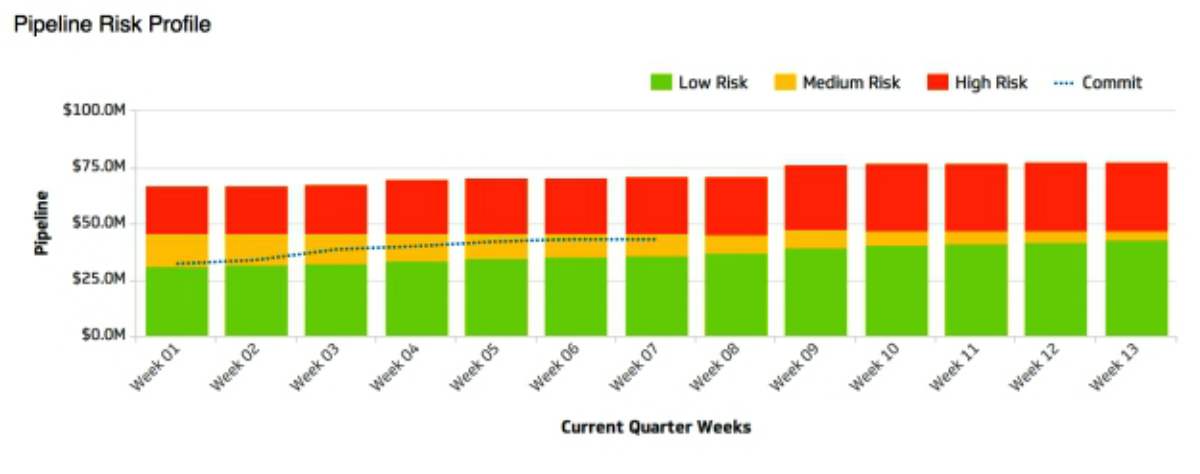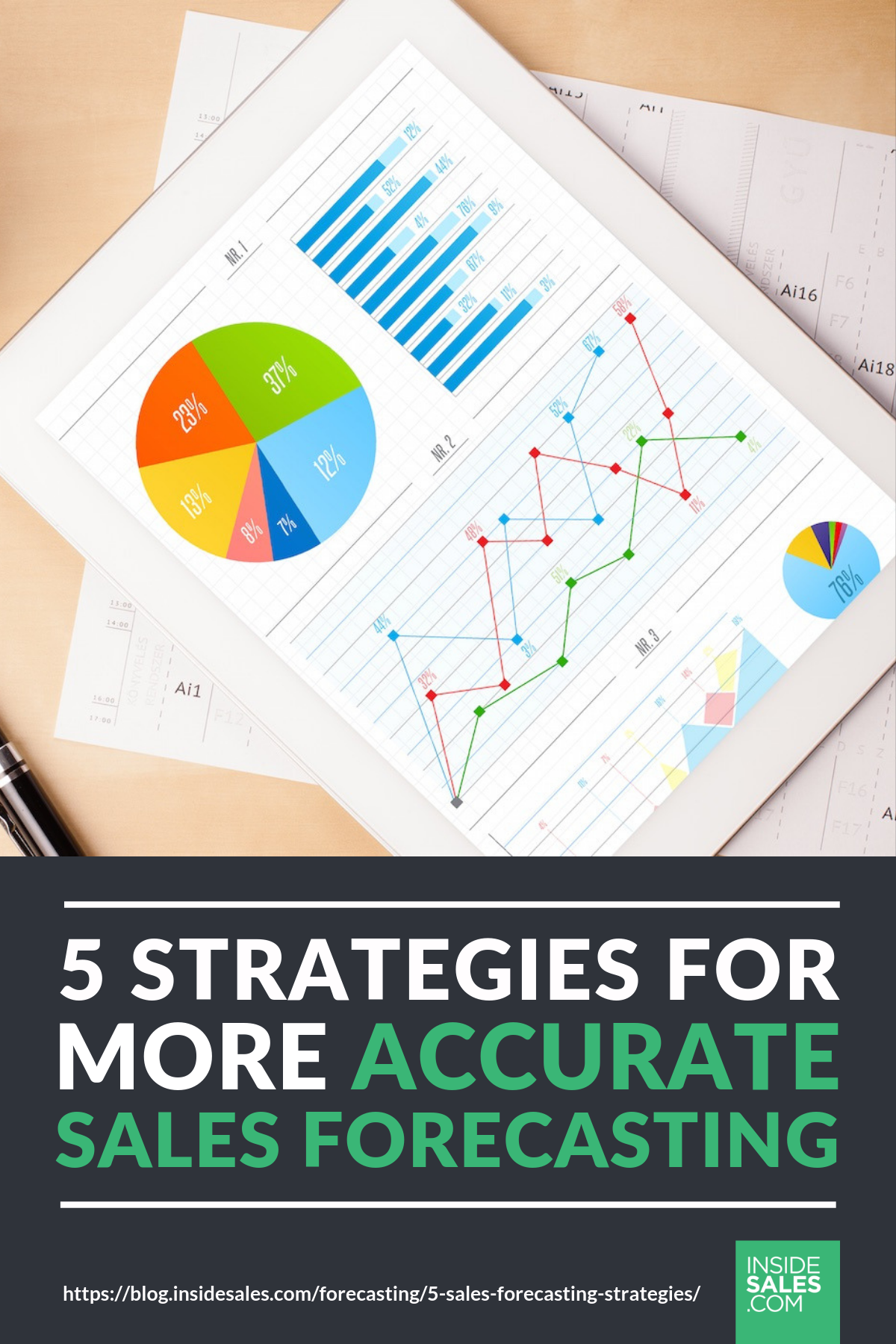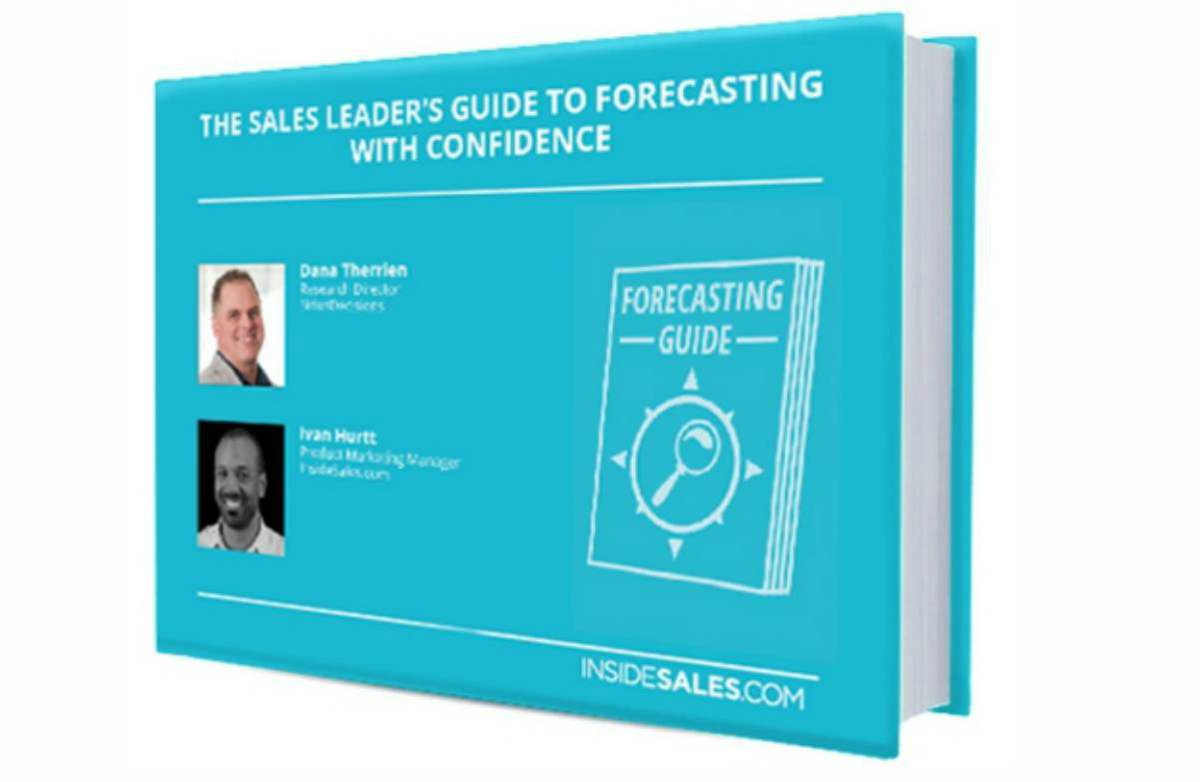6 Forecasting Strategies For More Accurate Sales [INFOGRAPHIC]
Can a more accurate sales forecasting process help in pulling in more revenue for businesses? Keep reading to check out these six strategies today.
RELATED: The Six Principles Of Sales Forecasting
In this article:
- How Sales Forecasting Affects A Business’ Decision-Making Process
- The Importance of Sales Forecasting
Making Accurate Sales Forecasting for Better Revenue
Click here to jump to the infographic.
How Sales Forecasting Affects A Business’ Decision-Making Process

An example of a sales forecasting chart.
What is sales forecasting? This process estimates future sales using actual sales data from your sales organization.
With so many business and finance leaders facing unprecedented market disruption and the need for wholesale transformation in their businesses, there has never been a more crucial time to get a grip on revenue forecasts. This is the perfect time for companies to take a serious look at making accurate sales forecasts.
Strong revenue predictability based on historical data provides a sound platform for the critical decisions that need to be made in these tumultuous times.
- “Intel to slash 12,000 jobs as forecast misses”
- “Expedia shares drop after missing revenue forecast”
These headlines spell out the obvious: predictability is something many businesses still can’t deliver. Although there is no silver bullet in revenue forecasting, my view is that the first place to look at is within the sales function.
Why? Well, I think it’s mostly dysfunctional.
The Importance of Sales Forecasting
In my experience, the sales profession considers forecasting as nothing more than a necessary evil that has been mandated by finance. I have lost count of the times I have heard, “It’s just a distraction from our real job of selling.”
What’s more, the sales data doesn’t lie, and there are endless metrics that showcase how dysfunctional sales forecasting is today:
According to SiriusDecisions, 79% of sales organizations miss their forecasts by more than 10%. CSO Insights reported in their most recent annual survey that about 54% of the deals forecast by reps never close.
So as the CFO, statistically, you might as well toss a coin if you want a more accurate forecast than the sales team is giving you.
According to SiriusDecisions, reps spend an average of 2.5 hours per week and managers 1.5 hours on forecasting. Yet, they often don’t anticipate missing targets or realize too late in the quarter to take action.
This isn’t sustainable for any business, so what can you do to fix this broken sales forecasting process?
Here are six strategies to use to build a more accurate sales forecast:
1. Ensure Sales Reps Maintain Accurate CRM Data
Make it mandatory and part of the culture to ensure that sales reps provide accurate data on deals and opportunities.
There are a number of ways to ensure this happens, including:
- Create dashboards to highlight good and poor data stewardship by team or by rep
- Setting up simple flags and alerts to highlight lazy and poor behaviors (e.g., an emailed alert to highlight deals with close dates in the past or deals that have close dates pushed by more than X times in a quarter)
Given the value of accurate data, some organizations have gone as far as linking KPIs and compensation to data hygiene. Ultimately, you need to hold sales leaders accountable for the data quality of their sales team.
You need the right data of your past performances to come up with an accurate prediction of future sales. Getting accurate sales forecasts relies on your sales managers’ ability to record the correct numbers of your current sales.
2. Make Your Sales Force Accountable for Forecast Accuracy
Link KPIs and compensation for forecasting accuracy.
Maybe this won’t be well received in the sales community, but nothing focuses the mind more than putting pay on the line. I have seen this work well when it was introduced alongside other change processes in sales forecasting (i.e., the implemention of a new tool or process).
In my experience, I have seen KPIs tied to a range of forecast tolerances, with the most common being in the range of +/- 5% of the opening forecast.
Set a doable sales process with a baseline for your sales reps to measure their performance with. This baseline should also be the basis for sales organizations to measure their overall performance.
Seeing a concrete and doable number as their monthly quota helps them focus on achieving their targets.
RELATED: 4 Bad Rep Behaviors That Lead To Inaccurate Sales Forecasting
3. Make the Forecasting Process Work for Sales and Finance

Working together for an accurate sales forecast
Keep it simple, and don’t overdo the frequency.
Nothing turns salespeople off more than making it time-consuming and tiring to forecast. Having to forecast too frequently or making the process overly taxing means it doesn’t get the sales team’s focus or attention it deserves.
You also end up taking away critical selling time, which hugely diminishes the sales team’s ability to deliver a sales forecast.
It’s impossible to use one single test to make forecasting sales easier, but you can develop a flexible process you can reevaluate and adjust whenever the need arises.
Sales managers need to consider other factors aside from the historical retail sales when making a forecasting report. They also need to look at other factors such as cash flow, product delivery, customer profile, and each sales rep’s sales history.
You also need to follow a consistent sales model and reporting process to follow for all departments involved. Using a standardized format helps in comparing year on year data without hassle.
Know When to Use the Right Sales Forecasting Methodology
The best way to make forecasting work for both the sales and finance team is by letting them get intimate with the different sales forecasting methods there is. By getting to know these different forecasting methods, they have an easier time consulting the right forecasting results for each of their needs.
If the finance team wants to forecast financial models, then they need the right method to give them the results that they want. They can forecast possible revenues and other relevant information and see reasonable sales projections.
For the sales reps, if they want to see how likely it is that they can close a deal, then there are specific methods for that as well.
Here are some standard sales forecasting techniques below for your reference:
- Average Sales Cycle: The sales cycle for the product or service you’re presenting your prospect differs, and knowing the average sales cycle beforehand can help reps prepare.
- Historical Sales Forecasting: Using historical data, your sales forecasting tool tells you the likeliest sales results you would get.
- Regression Analysis: This is a more complicated sales forecasting method that analyzes the factors that affect your sales results. Given these results, one can tweak their sales process as they see fit.
4. Provide the Right Tools for Sales Forecasting Methods
Use a common set of tools for pipeline management and forecasting.
Ensure that sales and finance teams use the same platform for sales pipeline management and forecasting processes. Any disconnect here opens up data challenges and typically wastes endless time discussing the validity of the numbers.
When forced to use the finance forecasting tool, it gives sales a reason not to update their data in the CRM system.
Use your CRM as the system of record for pipeline data and avoid spreadsheets at all costs. When you’re juggling multiple spreadsheets and the complexities of a global or matrixed organization, the errors and inaccuracies pile up.
What’s more, building and maintaining these complex spreadsheets is time-consuming and often incredibly expensive.
Deploy a pipeline analytics tool that can easily show you what has changed and provide both finance and sales early insight into deal and pipeline risk.
Ensure that the forecasting platform you are using gives both sales and finance what they need. Excel gives finance the flexibility to roll up the numbers in multiple dimensions (e.g., product, region, sales org), but it isn’t designed to handle the complexity of matrix, overlay, and channel sales organizations.
Deciding to purchase a sales forecasting software may cost the company an initial investment, but in time, it helps ease the workload from sales teams. This allows sales reps to focus more on making revenue rather than catching up on their reports.
Doing so also changes the way sales reps see sales forecasting as a time-consuming report to put off as long as possible.
Take the Time to Train Sales Reps on the Sales Forecasting Tools
A common mistake organizations make when they assign a new CRM for their sales team or finance teams is they don’t give them the time to acquaint themselves with the new system.
Learning about the sales forecasting tool they’re using should be gradual. It’s not a one-time thing.
Conducting training sessions occasionally helps sales reps who get more acquainted with the system level up their understanding of the system. That way, they get to use more features of their sales forecasting tools.
Instead of organizing a one, long training session for the sales forecasting tools, you should start by conducting basic training first. Eventually, as the reps get used to what they know, then more training sessions are added for the more intricate parts of the system.
It’s also essential that the sales manager also attends these training sessions as well. Since sales reps likely consult the sales manager for issues in their sales forecasting tools, they must be equipped with the knowledge to answer their questions.
5. Augment the Art of Forecasting With Science
Use data science to score deals by comparing them to deals you have won in the past.
So many sales forecasts are based on the “gut instinct” of the sales team. There is always some subjectivity in forecasting, but objective data should be the basis of judgments.
Historical trend data and top-down run rate predictions have some value in forecasting, but in today’s rapidly changing markets, a bottom-up, deal-by-deal forecast is essential.
The challenge here is that anecdotal details and personal judgments can dilute the accuracy of the numbers as they are rolled up through the sales organization. Sales managers usually know the right questions to ask, but they often lack time to inspect every opportunity, so this isn’t the fail-safe that most companies believe it is.
To get around this, I’m increasingly seeing companies utilizing the data science to score deals by comparing them to deals they have won in the past.
This provides an objective data-based view of a deal’s likelihood to close and gives a great benchmark with which finance functions can compare the sales leadership numbers.
Although the accuracy of these data science-based algorithms is shown to outperform human judgment, my advice is to use them to augment human forecasting processes, not replace them.
So, my takeaways are that forecasting has become a painful, time-consuming process. Wasted time cripples everyone, and company leaders don’t have the reliable projections they need to build a predictable business.
Integrate Sales Forecasting Results into Qualitative Data
As mentioned before, forecasting techniques in sales are more reliable than human judgment. However, this should not be the sole focus of your sales forecasting efforts.
Instead, what you should do is to supplement your qualitative data with the quantitative data available to you. This helps you create smarter business moves that are a combination of good business sense and data science.
Think of it this way: your qualitative data is the one pitching ideas to you, but your quantitative data is the one to approve or disapprove of these ideas.
These two types of data work hand-in-hand with one another instead of against each other as a lot of people might think. Therefore, you should make a continuous effort to let them balance each other out.
6. Understand Your Marketing Strategy and Funnel
Figure out what converts your prospective customer into closed clients.
Before making any decision on your sales forecasts, you need to understand your organization’s marketing funnel. This helps you figure out what drives your prospective client from one step to the next in your funnel.
What is a marketing funnel? This represents the buyer’s awareness and consideration of a product or service from initial contact until their decision to purchase.
To figure out how your customer’s journey affects sales forecasting, you need to consider the following metrics:
- Opportunities
- Qualified leads for marketing
- Qualified leads for sales
- Website and/or social media page visitors
By figuring out these metrics, your team can predict the number of possible leads your marketing efforts can generate. It can also predict the conversion rate and funnel velocity of your leads.
Once you use the information from both the conversation rate and funnel velocity, you can then predict how many initial leads are possible opportunities and how long this process takes.
Don’t forget to download, save, or share this handy infographic for reference:
![6 Forecasting Strategies For More Accurate Sales [INFOGRAPHIC]](https://www.insidesales.com/wp-content/uploads/2021/01/20191023-IS-6-Forecasting-Strategies-For-More-Accurate-Sales-scaled.jpg)
Bringing all of these together, you can be assured of a more accurate salesforce forecasting.
It’s time for the sales function to stand up and take accountability for its forecasting and become a real business partner to the finance team. For this to happen, the business also needs to deliver the right tools, processes, and cadence for accurate sales forecasting.
Use data and science alongside human insights in every forecasting judgment. Then, based on the sales forecasting results, you can set a realistic sales goal for your team and business.
What’s the biggest roadblock to accurate forecasting for your company? Share your experience with sales forecasting in the comments section below.
Up Next:
- XANT Solves Sales Forecasting Challenges With Predictive Pipeline
- You Suck at Sales Forecasting, and I Can Prove It
- What Is Artificial Intelligence and How Can You Start Using It to Be Successful
Discover how predictive forecasting can help you improve your forecast accuracy by grabbing the free ebook below.

Editor’s Note: This post was originally published on October 21, 2016, and has been updated for quality and relevancy.

